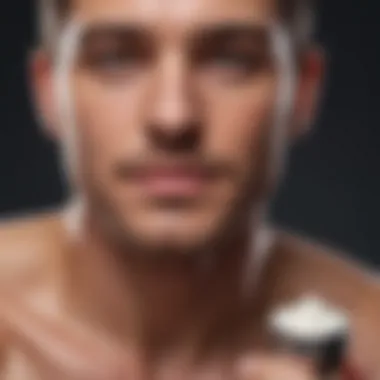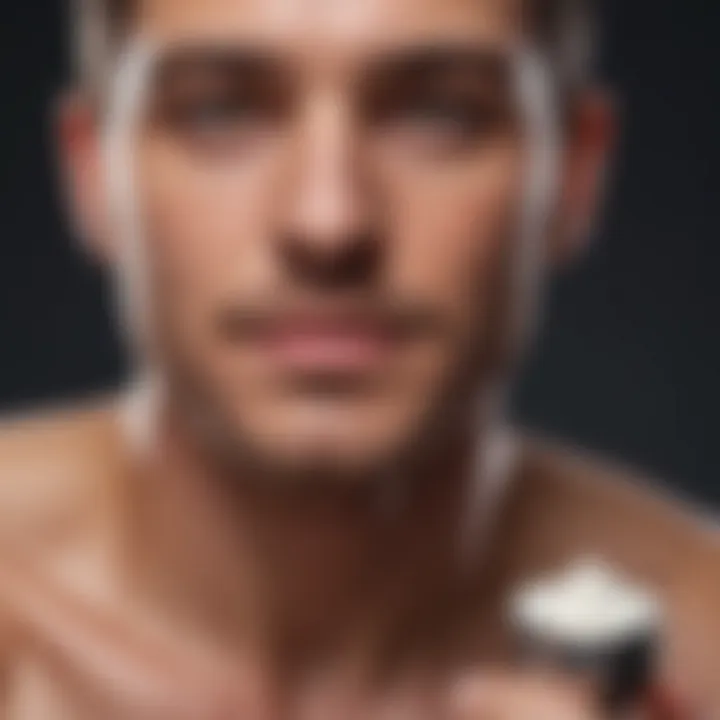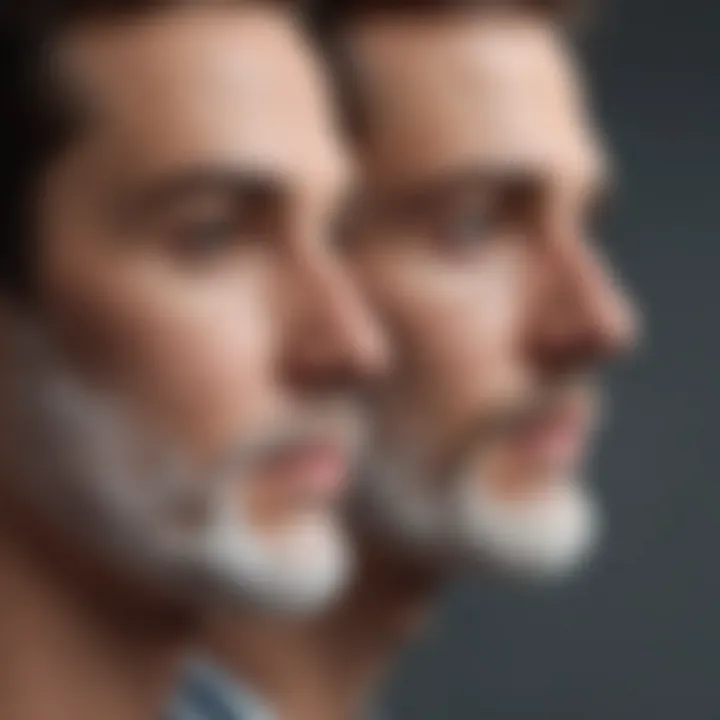Mastering the Art of Shaving: Techniques & Tips


Intro
Shaving is a fundamental personal care routine for many individuals. Yet, it often seems riddled with confusion. The choice of tools, techniques, and even the right direction to shave can significantly impact skin health and appearance. Understanding the nuances behind these decisions can empower you to tailor your shaving strategy to your particular needs. This guide aims to demystify the complex landscape of shaving, offering insights into the best practices for maintaining smooth, healthy skin.
In this comprehensive discussion, several key areas will be explored. First, we will dissect the critical question of which direction to shave—understanding its implications on skin irritation and hair growth. Next, popular shaving methods will be analyzed, including traditional razors, electric shavers, and safety razors, to shed light on their unique benefits and drawbacks. We will also delve into essential post-care routines, which are crucial for maintaining skin integrity after shaving. Finally, potential pitfalls in shaving will be addressed to help avoid common mistakes that can lead to negative outcomes.
By the end of this article, readers will not only grasp the importance of personalized shaving techniques but also develop strategies customized to their skin types and hair characteristics. With this knowledge, achieving optimal results can be a less daunting task.
Understanding the Basics of Shaving
Understanding the fundamentals of shaving is essential for anyone looking to achieve a smooth and irritation-free experience. Knowing the basics lays the groundwork for effective and personalized shaving routines. This section delves into the critical components of shaving that help in making informed decisions regarding techniques, tools, and preparation. By grasping these elements, readers can enhance not only the efficacy of their shaving practices but also the health of their skin.
The Anatomy of Hair and Skin
To appreciate the shaving process fully, one must first understand the components involved. Hair and skin are complex structures that each play a significant role. Hair grows from hair follicles, embedded in the dermal layer of the skin. Understanding the growth cycle of hair can inform when to shave for optimal results. For instance, shaving during the anagen phase, when the hair is actively growing, may yield a smoother finish compared to the telogen phase, when the hair is shedding.
Moreover, skin possesses multiple layers, with the outermost layer acting as a protective barrier. This barrier can be sensitive, making it imperative to take care when shaving. Different skin types—such as oily, dry, or combination—react differently to shaving techniques and products. Therefore, knowing one’s hair type and skin condition can significantly influence the choice of shaving method.
"Understanding hair and skin anatomy helps in choosing the right shaving approach, leading to better results."
Importance of Shaving Preparation
Proper preparation is a cornerstone of effective shaving. It encompasses various steps that prime skin and hair for the shaving process. Initially, exfoliation should be considered. This process removes dead skin cells, allowing for a closer shave while reducing the risk of clogging hair follicles.
Additionally, foregoing or skimping on prep can lead to common issues such as razor bumps, irritation, and even ingrown hairs. Hydrating the hair is equally critical. Using warm water can soften hair, making it easier to cut. Choosing the right product, be it a cream or gel, also has a significant impact on the shaving experience. A quality product lubricates the skin and reduces friction, further minimizing irritation.
In summary, dedicating time to preparation increases the likelihood of achieving a comfortable shave, while considering both hair and skin anatomy ensures a personalized experience.
Which Way to Shave: The Fundamentals
Understanding how to effectively shave is crucial for achieving optimal results while maintaining skin health. This segment will explore the various techniques associated with the direction of shaving. The direction one chooses to shave impacts not only the efficiency of hair removal but also the condition of the skin post-shave. For many individuals, the right technique can make the difference between smooth skin and discomfort or irritation. Additionally, knowing how hairs grow can help in determining the best shaving method for each individual.
Shaving with the Grain
Shaving with the grain refers to shaving in the same direction that hair grows. This technique is often recommended for those with sensitive skin or hair that is particularly coarse. When you shave with the grain, it reduces the risk of tugging on the hair and irritations to the skin. Moreover, this method is more forgiving and less likely to result in razor burn.
Some considerations when shaving with the grain include:
- Technique: Use light, short strokes to manage the razor's movement effectively.
- Preparation: Always ensure proper skin preparation before shaving. Warm water helps soften the hairs and open pores.
- Product choice: A good quality shaving cream or gel can help lubricate the skin, making the shaving process smoother.
Shaving Against the Grain
Shaving against the grain means cutting hair in the opposite direction of its growth. This method tends to deliver a closer shave, which many prefer, especially in areas where hair grows downward. However, this technique can lead to increased chances of ingrown hairs and irritation, particularly for those with sensitive skin.
Key points to consider when shaving against the grain:
- Skin type: Know your skin's tolerance. If previous experiences have resulted in irritation, consider avoiding this method altogether.
- Angle: The angle of the razor can play a significant role. A shallower angle may reduce irritation while still providing a closer shave.
- Moisturization: Always follow up with a soothing aftershave product or moisturizer to help soothe the skin post-shave.
Cross-Grain Techniques


Cross-grain techniques involve shaving horizontally across the direction of hair growth. This approach often provides a balance between the first two methods. It may help capture any missed hairs while minimizing the risk of irritation associated with shaving against the grain.
Things to keep in mind with cross-grain techniques:
- Assessment: Understand the hair's growth pattern in the area being shaved to effectively adjust the angle.
- Layering methods: Many find success in incorporating cross-grain shaving after completing a with-the-grain pass.
- Product application: The same principles of skin hydration apply here. Proper application of shaving cream or gel can enhance the experience significantly.
"Finding the right direction to shave is not merely about aesthetics but also a commitment to the health of your skin."
Shaving Tools and Their Impact
Shaving tools significantly influence the shaving experience and the results. Understanding these tools is key for making informed choices that lead to healthier skin and a more effective shave. Each tool comes with its design, purpose, and method of use, affecting both the ease and outcome of shaving. The right tool can prevent skin irritation and enhance the overall experience, while the wrong choice may lead to discomfort and suboptimal results.
Types of Razors and Their Uses
Straight Razors
Straight razors are traditional tools that offer a close shave. They are characterized by their single, sharp blade, which users manually use to shave. The key aspect of straight razors is their longevity. With proper maintenance, these razors can last a lifetime. This sustainability makes them a popular choice for eco-conscious individuals. However, they require skill and practice to use correctly, which can be daunting for some. A significant advantage of straight razors is their ability to provide an extremely close shave, reducing irritation for those with the right technique. On the contrary, they need regular honing and stropping to maintain their sharpness.
Safety Razors
Safety razors feature a guarded blade, making them ideal for beginners. They tend to be less intimidating than straight razors. Their design promotes safety, which minimizes the risk of nicks and cuts. Safety razors also offer versatility, allowing users to swap out blades based on their preferences. Many users find that these razors not only provide a comfortable shave but also save money in the long run, as replacement blades are generally affordable. The disadvantage lies in the learning curve, though it is not as steep as that of straight razors. Overall, safety razors strike a balance between efficiency and ease of use.
Disposable Razors
Disposable razors are convenient and accessible, making them a common choice for many. Their key characteristic is the ability to toss them out after use. This convenience is perfect for travel or for those who prefer a no-fuss approach to shaving. Disposable razors often come with multiple blades and built-in lubrication strips to enhance comfort. However, they may not provide the same quality of shave as straight or safety razors. The blades can dull quickly, leading to skin irritation. While they offer ease, frequent users may miss the close and refined shave of more enduring tools.
Choosing the Right Shaving Cream or Gel
A suitable shaving cream or gel is crucial for a smooth shave. This product helps to moisturize the skin and soften the hairs, allowing for a gliding motion that reduces friction. Look for products that contain soothing ingredients like aloe vera or chamomile. Also, foams or gels that create a thick lather can enhance lubrication, minimizing the risk of razor burns.
The Role of Pre-Shave Oils
Pre-shave oils serve as an additional layer of protection for the skin. By applying this oil before shaving, users can create a barrier that softens the hair and locks in moisture. The oil helps the razor glide smoothly across the skin, reducing irritation. Choosing an oil with natural ingredients can provide additional nourishment, contributing to healthier skin post-shave.
Identifying the Right Technique
Choosing the right shaving technique is pivotal for achieving the best results in any shaving endeavor. Not only does this aspect determine the effectiveness of hair removal, but it also influences skin health and comfort. Understanding how to tailor your approach based on individual needs minimizes the risk of irritation, enhances overall satisfaction, and leads to a more positive grooming experience. Personalization in shaving techniques can mean the difference between a smooth finish and a troublesome irritation.
Techniques for Sensitive Skin
Sensitive skin requires special care during shaving. This type of skin often reacts negatively to common shaving practices, leading to redness, burning, or breakouts. To mitigate these issues, the following suggestions can provide relief and enhance comfort:
- Opt for a gentle razor. Using a razor designed for sensitive skin minimizes irritation. Razors with fewer blades may also be effective in this case.
- Pre-shave preparation is key. Softening the hairs and skin with warm water, followed by the application of a pre-shave oil, can make a significant difference. This approach eases the shaving process, allowing for a smoother glide.
- Avoid harsh products. Use fragrance-free and alcohol-free shaving creams or gels. These options are less likely to irritate your skin during or after shaving.
- Shave with the grain. This technique reduces the chances of ingrown hairs and irritation, especially when dealing with sensitive areas like the neck or face.
By focusing on these specifics, individuals with sensitive skin can shave effectively without compromising skin health.
Adapting Methods for Different Hair Types
It is essential to recognize that various hair types require tailored shaving techniques. Thick, coarse hair may necessitate a different approach than fine, soft hair. Here are practical strategies for different hair types:


- Coarse Hair: Those with thicker hair should consider using multiblade razors or straight razors to ensure a close cut. Employing shaving cream with added moisture can help soften the hair, making the shaving process easier.
- Fine Hair: For finer hair, a simple safety razor often suffices. This type allows for precision without risking irritation from overly aggressive blades.
- Growth Direction: Recognizing the growth direction of your hair can greatly influence your technique. Adjust your shaving movement to flow with these growth patterns to maximize comfort and effectiveness.
In summary, adapting methods based on hair types enhances efficacy and significantly reduces skin concerns.
Shaving in Challenging Areas
Certain body regions present unique challenges during shaving. These areas may include underarms, bikini lines, and the face. Special care should be taken in these situations:
- Underarms: Users should shave after a warm shower when hair is softer. To navigate the curves, consider using a small razor designed for precision.
- Bikini Lines: This area is often sensitive. Trimming hair with scissors first may be beneficial before shaving to reduce tugging and irritation. Always apply pre-shave oil to avoid ingrown hairs.
- Facial Areas: The curves of the jaw and chin require careful attention. Using a razor with a pivoting head can help in these tricky spots. Employ short, controlled strokes to maintain a steady hand and avoid nicks.
A personalized approach to shaving in challenging areas reduces discomfort and enhances the overall experience.
By identifying the right technique tailored to specific needs, one can transform shaving into a simple and less stressful task.
Post-Shaving Care
Post-shaving care plays a crucial role in maintaining healthy skin and ensuring a comfortable shaving experience. After shaving, the skin is often sensitive and reacts to environmental stressors. Attention to this phase helps prevent complications like irritation or discomfort. Prioritizing post-shaving routines can significantly enhance overall skin health and appearance. The choice of products and techniques used in this stage can make a difference that is felt well beyond the day of shaving.
Importance of Aftershave Products
Using aftershave products is vital in the aftermath of shaving. These products serve multiple purposes. Firstly, they offer hydration that is essential after the hair removal process. Shaving can strip natural moisture from the skin, leading to dryness. Aftershave balms or lotions replenish this lost moisture, nurturing the skin.
Secondly, aftershave products can provide a soothing effect. Many formulations include ingredients like aloe vera or chamomile, known for their calming properties. These elements help reduce redness and irritation, providing comfort to sensitive skin.
Lastly, aftershaves can act as a protective barrier. They often contain antiseptic ingredients that minimize the risk of infection from small cuts or nicks incurred during shaving. In summary, aftershave products not only promote skin health but also enhance the overall shaving experience.
Dealing with Irritations and Razor Burns
Irritations and razor burns are common complaints among those who shave. These issues frequently result from improper techniques or product usage. Understanding how to effectively manage them is essential for a smooth recovery after shaving.
To mitigate irritations, one should choose soft, non-abrasive razors. Regularly replacing blades ensures they remain sharp, reducing the chance of skin trauma. Additionally, applying a cool compress to the affected area immediately after shaving can soothe the skin and reduce inflammation.
For razor burns specifically, several remedies can be beneficial. Cooling gels containing menthol can provide instant relief. Alternatively, oatmeal lotions are thoughtful choices known for their anti-inflammatory properties. In severe cases, over-the-counter hydrocortisone creams can help alleviate the discomfort.
Common Mistakes to Avoid
Understanding the common mistakes made during shaving is essential for achieving optimal results. Many individuals overlook important factors that contribute to irritation or subpar outcomes. By identifying and rectifying these errors, you can enhance your shaving experience and protect your skin’s health. Key mistakes in this regard can lead not only to discomfort but also to long-term skin issues. So, let's examine two prevalent mistakes that should be avoided for a more successful shaving routine.
Over-Exfoliating the Skin
Exfoliation is generally a beneficial practice in skincare. However, over-exfoliating—especially before shaving—can have adverse effects. Excessive removal of skin cells can lead to sensitivity and dryness. When you exfoliate too frequently or aggressively, the skin barrier weakens. This makes skin prone to irritations during shaving.
To prevent over-exfoliation, be mindful of the frequency and technique you use. It is advised to limit exfoliation to once or twice a week, depending on your skin type. If you have sensitive skin, use a gentle exfoliant. Here are some simple guidelines to follow:
- Choose mild exfoliants: Opt for formulas designed for sensitive skin.
- Limit frequency: Stick to once or twice a week.
- Avoid physical scrubs: They can be harsh; prefer chemical exfoliants if necessary.
It is crucial to remember that a well-prepared skin surface enhances the glide of the razor and reduces the likelihood of irritation. After all, a carefully cared-for epidermis can perfectly align with your shaving goals.
Using Dull Razors


The use of dull razors is another common pitfall. While it may seem trivial, a razor's sharpness plays a significant role in achieving a smooth shave. Dull blades pull on hair rather than cutting it cleanly. This can lead to increased irritation, ingrown hairs, and razor burns. Once you notice that your razor isn't cutting effectively, it's time to replace it.
To maintain an effective shaving routine, consider the following recommendations:
- Inspect your razor: Regularly check the blade for dullness.
- Change razors timely: Depending on frequency of use, change blades every 5 to 10 shaves.
- Store wisely: Keep razors in a dry place to avoid rusting and dullness.
A sharp razor will provide the closest shave possible. With an efficient blade, the risk of cuts and irritations decreases significantly. Leveraging a quality tool remains one of the best investments for your skincare routine.
Tailoring Shaving to Individual Needs
Tailoring shaving methods to individual needs is essential for both effectiveness and comfort. Each person's skin type, hair texture, and personal preferences vary significantly. Recognizing these differences can have a profound impact on the shaving experience and the results achieved. A tailored approach allows individuals to mitigate common problems such as irritation, ingrown hairs, and uneven shave results. This section explores how to adapt shaving techniques for various body areas and considers the wider cultural perspectives that influence shaving practices.
Adapting Techniques for Different Body Areas
Different body areas require unique shaving techniques. For instance, the delicate skin of the face, underarms, and bikini area is more vulnerable and particularly prone to irritation. It is vital to use appropriate tools and products in these areas to ensure safety and comfort.
- Face Shaving: Use a razor designed for sensitive skin, and ensure that the skin is well-hydrated. The technique should include shaving with the grain to minimize irritation.
- Armpit Shaving: It is beneficial to shave in the direction of hair growth to prevent irritation and ingrown hairs. Employing a mild, soothing shaving gel can also help.
- Bikini Area: This area is very sensitive. Using a light, protective shave cream can help reduce friction. Shaving against the grain might be necessary for a closer shave, but caution is important to avoid cuts.
"Understanding the unique characteristics of each body area is key to achieving a smooth shave with minimal discomfort."
Considering Cultural Perspectives on Shaving
Cultural views on shaving significantly impact how individuals approach this personal grooming task. In some cultures, shaving may be deeply entrenched in traditions or rituals. For instance, many women in certain regions may adhere to specific practices that are considered standard for beauty, while others may choose not to shave at all for personal or cultural reasons.
Cultural beliefs influence not just the decision on whether to shave but also the methods and tools used. In many Western contexts, the emphasis might be on efficiency and aesthetics, whereas other cultures may prioritize journey and ceremony in the shaving process.
Recognizing these variations is important, especially for individuals who are exploring different shaving methods or who are new to shaving practices.
- Cultural Awareness: Acknowledging diverse cultural attitudes towards shaving can enhance understanding and acceptance of varied practices.
- Personal Choice: Ultimately, shaving is a personal decision, and learning about different perspectives may encourage individuals to create their own defined practices that address their unique needs without societal pressures.
Tailoring these aspects of shaving not only promotes positive outcomes in skin health but also empowers individuals to embrace their choices confidently.
Epilogue and Recommendations
In summary, this article has explored various aspects of shaving, providing a thorough understanding of techniques and tools that cater to individual needs. The importance of recognizing the right shaving direction cannot be understated. Choosing the most suitable method for your skin type and hair growth can lead to smoother skin and reduced razor irritation.
When considering recommendations, remember to prioritize preparation. Ensure your skin is clean and well-hydrated before the act of shaving. This preparatory step is crucial as it not only enhances the effectiveness of the razor but also minimizes the risk of nicks and cuts. Additionally, be mindful of the tools you are using. Investing in high-quality razors and creams can make a significant difference in the overall shaving experience.
"The right tools and techniques empower you to achieve desired results with confidence."
Also, it is essential to adapt techniques that suit different areas of the body. Shaving the legs might require different approaches compared to facial shaving. Tailoring methods to each region addresses the unique challenges posed by varying hair thickness and skin sensitivity.
Summarizing Key Insights
Throughout this guide, key insights have emerged regarding the fundamentals of shaving. The decision of whether to shave with or against the grain stands out as a primary concern. Shaving with the grain is typically gentler on the skin and helps reduce irritation, whereas shaving against the grain can yield a closer shave but may increase the risk of razor bumps.
Moreover, proper post-shaving care is equally important. Using aftershave products formulated for your skin type can aid in healing and soothe potential irritations. The balance between achieving a closer shave and maintaining skin health is crucial and should guide your choices.
Clear understanding of your hair type and skin condition plays an instrumental role in shaping your shaving routine. People with sensitive skin may benefit from lower pressure and gentler techniques, while those with coarser hair may need to adopt a more robust method.
Encouraging Personal Experimentation
Finally, personal experimentation is a valuable part of honing your shaving technique. Everyone's skin and hair are unique. Therefore, encouraging readers to try different products and methods empowers them to discover what works best for them. Testing various razors, creams, and shaving patterns can lead to individualized techniques that enhance both results and comfort.
Take note of how your skin reacts after trying different methods. This observation can provide insights into necessary adjustments—whether it's changing your shaving frequency, the direction of shaving, or even the type of razor you choose.



